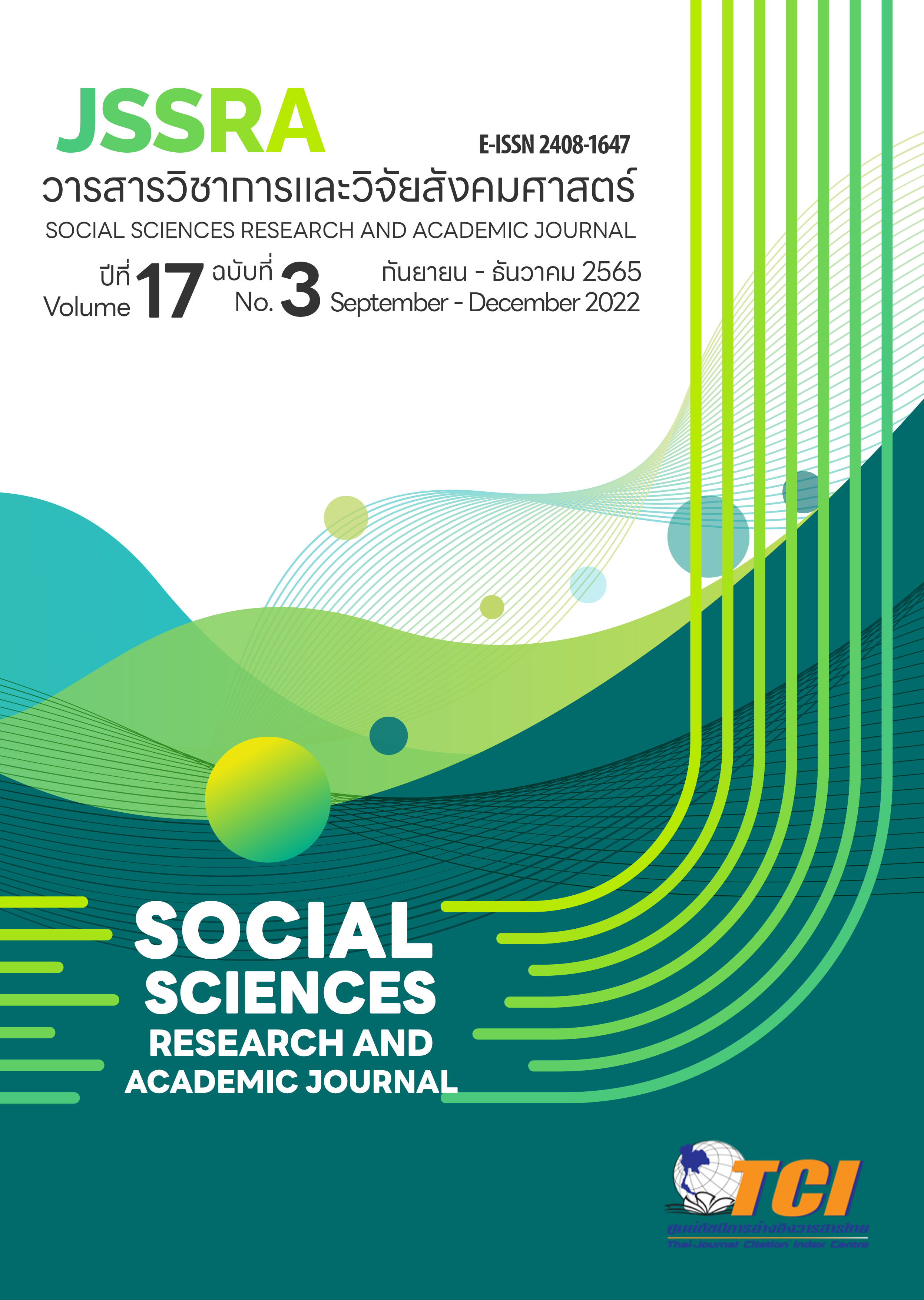การพัฒนาและการตรวจสอบคุณภาพมาตรวัดการรับรู้การเปลี่ยนแปลงที่มากเกินกว่าจะรับได้สำหรับอาจารย์มหาวิทยาลัยในประเทศไทย The Development and Validation of Perceived Excessive Change Scale of University Lecturers in Thailand
Main Article Content
Abstract
วัตถุประสงค์ของการศึกษานี้ (1) เพื่อพัฒนาและตรวจสอบคุณภาพของมาตรวัดการรับรู้การเปลี่ยนแปลงที่มากเกินกว่าจะรับได้สำหรับอาจารย์มหาวิทยาลัยในประเทศไทย และ (2) เพื่อศึกษาองค์ประกอบของมาตรวัดการรับรู้การเปลี่ยนแปลงที่มากเกินกว่าจะรับได้สำหรับอาจารย์มหาวิทยาลัยในประเทศไทย โดยมาตรวัดนี้พัฒนาขึ้นจากแนวคิดทฤษฎีที่เกี่ยวข้อง และผ่านการตรวจสอบคุณสมบัติทางการวัดต่าง ๆ ได้แก่ ความเที่ยงตรงเชิงเนื้อหา ความเที่ยงตรงเชิงโครงสร้าง ความเที่ยงตรงตามเกณฑ์สัมพันธ์ ค่าสัมประสิทธิ์สหสัมพันธ์ระหว่างคะแนนรายข้อกับคะแนนรวม และการตรวจสอบค่าความเชื่อมั่นของการวัด รวมทั้งใช้การวิเคราะห์องค์ประกอบเชิงสำรวจเพื่อศึกษาองค์ประกอบ โดยเก็บข้อมูลจากแบบสอบถามลักษณะออนไลน์กับอาจารย์มหาวิทยาลัยในประเทศไทย จำนวน 234 คน
ผลการวิเคราะห์องค์ประกอบเชิงสำรวจ พบว่า มาตรวัดการรับรู้การเปลี่ยนแปลงที่มากเกินกว่าจะรับได้ ของอาจารย์มหาวิทยาลัยในประเทศไทยซึ่งประกอบด้วย 12 ข้อคำถาม มี 2 องค์ประกอบ ได้แก่ ความถี่ของการเปลี่ยนแปลงในองค์กร และผลกระทบทางลบจากการเปลี่ยนแปลงในองค์กร โดยทั้งสององค์ประกอบร่วมกันอธิบายความแปรปรวนได้ประมาณร้อยละ 69 และมีความสัมพันธ์อย่างมีนัยสำคัญกับคะแนนความอ่อนล้าทางอารมณ์ และการลดความเป็นบุคคล มีค่าความเชื่อมั่นในการวัดต่างๆ อยู่ในระดับดี ดังนั้นมาตรวัดการรับรู้การเปลี่ยนแปลงที่มากเกินกว่าจะรับได้สำหรับอาจารย์มหาวิทยาลัยในประเทศไทยที่พัฒนาขึ้นมีคุณภาพในการวัดที่เที่ยงตรง เชื่อถือได้ และสามารถนำไปใช้ได้ต่อไป
The purpose of this study aimed to (1) develop and validate the perceived excessive change scale of Thai university lecturers, and (2) examine the excessive change’s factors of university lecturers in Thailand. The scale was constructed based on related theories. Psychometric tests were conducted to assure its reliability and validity properties. There was content validity, construct validity, criterion-related validity, item-total correlation, reliability and using exploratory factor analysis to extract its dimension. The data was collected from 234 university lecturers in Thailand by online questionnaire method.
Results of exploratory factor analysis indicated that the perceived excessive change scale of university lecturers in Thailand consisted of 12 items with 2 factors; change frequency and change impact. These 2 factors accounted for 69% of the total variance and there was a significantly relationship with emotional exhaustion and depersonalization. The reliability of measure shows satisfactory psychometric quality. Thus, the developed scale is valid, reliable and can be used for further study.
Article Details
References
กรมสุขภาพจิต. (2562). ภาวะหมดไฟในการทำงาน (burnout syndrome). สืบค้นเมื่อวันที่ 5 เมษายน 2564, จาก https://www.dmh.go.th/news/view.asp?id=2270
กรุงเทพธุรกิจ. (2563). เด็กรุ่นใหม่เรียนป.ตรีน้อยลง สถาบันการศึกษาดิ้นปรับตัว. สืบค้นเมื่อวันที่ 5 เมษายน 2564, จาก https://www.bangkokbiznews.com/news/902052
เจษฎา คูงามมาก, และ พาชิตชนัต ศิริพานิช. (2557). ความเครียดในการทำงานของอาจารย์มหาวิทยาลัยรัฐ, วารสารพัฒนบริหารศาสตร์, 54 (1), 259-285.
นันทาวดี วรวสุวัส, ลักษณา สกุลทอง, กุลิสรา พิศาลเอก, มนัสพงษ์ มาลา, และ ปราณี เนวนิตย์. (2560). การพัฒนารูปแบบการสร้างเสริมภูมิคุ้มกันทางใจ ป้องกันภาวะหมดไฟ ดูแลใจคนทำงาน สำหรับเจ้าหน้าที่สาธารณสุข เขตสุขภาพที่ 7 (EPI-BP Model). ขอนแก่น: ศูนย์สุขภาพจิตที่ 7.
บุญใจ ศรีสถิตย์นรากูร. (2555). การพัฒนาและตรวจสอบคุณภาพเครื่องมือวิจัย: คุณสมบัติการวัดเชิงจิตวิทยา. กรุงเทพฯ: โรงพิมพ์แห่งจุฬาลงกรณ์มหาวิทยาลัย.
สมาคมการจัดการธุรกิจแห่งประเทศไทย. (2563). ทำความรู้จัก VUCA. สืบค้นเมื่อวันที่ 10 เมษายน 2564, จาก https://tma.or.th/2016/news_detail.php?id=426
Abrahamson, E. (2000). Change without pain. Harvard Business Review, 75-79.
Abrahamson, E. (2004). Avoiding Repetitive Change Syndrome. MIT Sloan Management Review, 45(2), 93-95.
Caldwell, S. D., Herold, D. M., & Fedor, D. B. (2004). Toward an understanding of the relationships among organizational change, individual differences, and changes in person-environment fit: A cross-level study. Journal of Applied Psychology, 89, 868-882.
Cattell, R. B. (1966). The scree test for the number of factors. Multivariate Behavioral Research, 1(2), 245-276, DOI: 10.1207/s15327906mbr0102_10
Cohen, J. (1988). Statistical Power Analysis for the Behavioral Sciences. (2nd ed.). Hillsdale, NJ: Erlbaum.
Comrey, A. L., & Lee, H. B. (1992). A first course in factor analysis (2nd ed.). Lawrence Erlbaum Associates, Inc.
Costello, Anna B., & Jason Osborne. (2005). Best practices in exploratory factor analysis: four recommendations for getting the most from your analysis. Practical Assessment Research & Evaluation, 10(7). DOI: https://doi.org/10.7275/jyj1-4868
Falkenberg, J., Stensaker, I. G., Meyer, C. B., & Cathrin Haueng, A. (2005). When change becomes excessive, Research in Organizational Change and Development, 15, 31-62.
Hair, J.F., Black, W.C., Babin, B.J., Anderson, R.E. and Tatham, R.L. (2010) Multivariate Data Analysis. 7th Edition, Prentice Hall, Upper Saddle River.
Hair, J., Black, W., Babin, B., & Anderson, R. (2014). Multivariate Data Analysis (7th ed.). New Jersey: Pearson Educational, Inc.
Henson, R. K. & J. K. Roberts (2006). Use of Exploratory Factor Analysis in Published Research: Common Errors and Some Comment on Improved Practice. Educational and Psychological Measurement, 66(3), 393-416.
Herscovitch, L., & Meyer, J. P. (2002). Commitment to organizational change: Extension of a three-component model. Journal of Applied Psychology, 87(3), 474–487. https://doi.org/10.1037/0021-9010.87.3.474
Johnson, K. J. (2016). The dimensions and effects of excessive change. Journal of Organizational Change Management, 29(3), 445-459.
Johnson, K. J., Bareil, C., Giraud, L., & Autissier, D. (2016). Excessive change and coping in the working population. Journal of Managerial Psychology, 31(3), 739-755.
Kaiser, H. (1960). Review of Sender's Measurement and statistics. Psychometrika, 25, 411-413.
Laura J. Burton, & Stephanie M. Mazerolle (2011). Survey Instrument Validity Part I: Principles of Survey Instrument Development and Validation in Athletic Training Education Research. Athletic Training Education Journal , 6(1), 27-35.
Lloret, S., Ferreres, A., Hernandez, A., & Tomas, I. (2017). The exploratory factor analysis of items: Guided analysis based on empirical data and software. Anales de Psicologia, 33, 417-432. doi:10.6018/analesps.33.2.270211
López-Núñez, M.I., Rubio-Valdehita, S., Diaz-Ramiro, E.M., & Aparicio-García, M.E. (2020). Psychological Capital, Workload, and Burnout: What’s New? The Impact of Personal Accomplishment to Promote Sustainable Working Conditions. Sustainability, 12, 8124. https://doi.org/10.3390/su12198124
Pallant, J. (2016). SPSS Survival Manual: A Step by Step Guide to Data Analysis Using SPSS Program. (6th ed.). London:McGraw-Hill Education.
Rafferty, A. E., & Griffin, M. A. (2006). Perceptions of organizational change: A stress and coping perspective. Journal of Applied Psychology, 91(5), 1154–1162. https://doi.org/10.1037/0021-9010.91.5.1154
Stensaker, I., Meyer, C. B., Falkenberg, J., & Haueng, A. C. (2002). Excessive Change: Coping Mechanisms and Consequences. Organizational Dynamics, 31(3), 296-312.
Tabachnick, B. G., & Fidell, L. S. (2013). Using Multivariate Statistics. (6th ed.). Boston, MA: Pearson.
Thompson, B. (2004). Exploratory and confirmatory factor analysis: understanding concepts and applications. Washington, DC : American Psychological Association.
Thompson, B., & Daniel, L.G. (1996). Factor analytic evidence for the construct validity of scores: a historical overview and some guidelines. Educational and Psychological Measurement, 56(2), 197-208.


